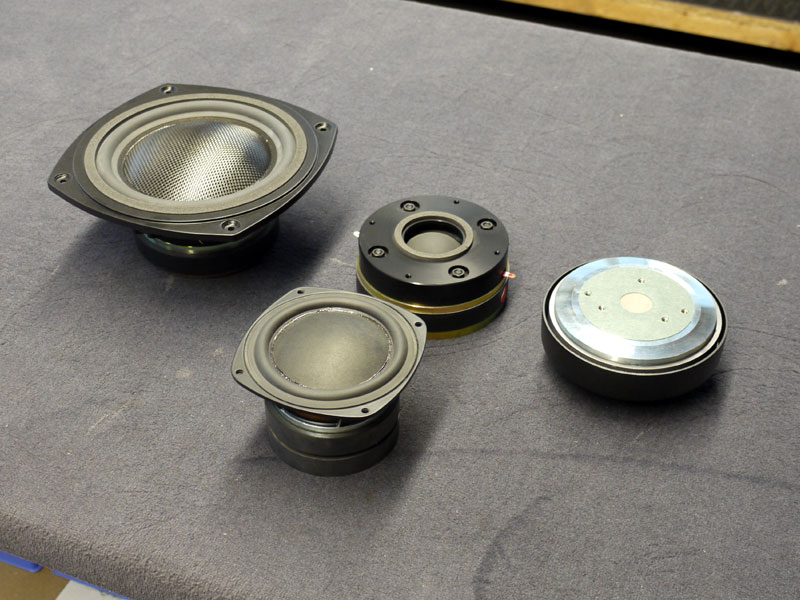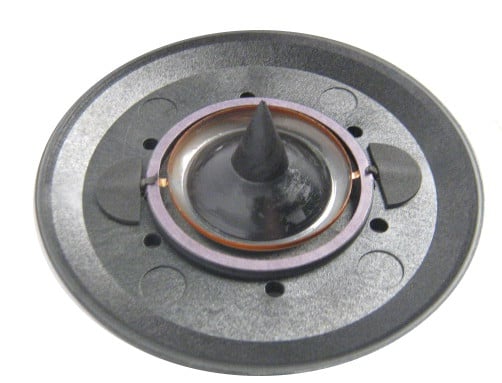"Is that really a CD?:
Yes, it really is.
Look at the taper on the face plate, and how it continues the taper on the cone. Look at the taper on the phase plug, see how it matches the taper on the face plate. Look at how much of the cone is blocked by the phase plug, consider how much compression is occurring.
The horn is quite shallow, so it can't load very low in frequency, but it is active horn loaded in the top octave.
If you want to hear what the horn faceplate actually does, just remove it (the driver is twist-locked onto the faceplate). I think you will be surprised at how much it contributes to the sound.
Avantgarde uses a custom compression driver for the midrange in the Trio, the compression ratio is on the order of 2:1, and it sounds very open compared to typical 10:1 midrange drivers.

Compression Ratio: 1.84:1
http://www.communitypro.com/files/literature/spec%20sheets/M200A_SPEC.pdf?phpMyAdmin=c9cc5b3953d87385dc22218d669e7aab
Yes, it really is.
Look at the taper on the face plate, and how it continues the taper on the cone. Look at the taper on the phase plug, see how it matches the taper on the face plate. Look at how much of the cone is blocked by the phase plug, consider how much compression is occurring.
The horn is quite shallow, so it can't load very low in frequency, but it is active horn loaded in the top octave.
If you want to hear what the horn faceplate actually does, just remove it (the driver is twist-locked onto the faceplate). I think you will be surprised at how much it contributes to the sound.
Avantgarde uses a custom compression driver for the midrange in the Trio, the compression ratio is on the order of 2:1, and it sounds very open compared to typical 10:1 midrange drivers.

Compression Ratio: 1.84:1
http://www.communitypro.com/files/literature/spec%20sheets/M200A_SPEC.pdf?phpMyAdmin=c9cc5b3953d87385dc22218d669e7aab
The 2360 horn has 30% THD with 5W input at 10Khz (for instance) driven by a 2445, the M200A on the SH494 has less than 4% (in the midrange where it runs), at 7.5W input. It probably has even less distortion on the Trio mid horn.
400 Hz - 4 kHz (±3.2dB), 111 dB/1W/1M SPL (400 Hz - 4 kHz 1/3 octave bands), 7.5W is about 120dB!
The tweeter for the Trio is a high-compression ratio Beyma 1", CLS just wants too much for their VHF100 low compression (4:1) tweeter driver, which has less moving mass than a TAD 2001. This tweeter is so clean it doesnt sound like it has any HF (I had to get out the analyzer to check and see!).

Looks a bit like a BMS driver, but is really quite different, one half of the ring is missing, and it is only clamped on one side.
400 Hz - 4 kHz (±3.2dB), 111 dB/1W/1M SPL (400 Hz - 4 kHz 1/3 octave bands), 7.5W is about 120dB!
The tweeter for the Trio is a high-compression ratio Beyma 1", CLS just wants too much for their VHF100 low compression (4:1) tweeter driver, which has less moving mass than a TAD 2001. This tweeter is so clean it doesnt sound like it has any HF (I had to get out the analyzer to check and see!).

Looks a bit like a BMS driver, but is really quite different, one half of the ring is missing, and it is only clamped on one side.
Last edited:
By the above logic, covering any part of a tweeter that has a bevelled face plate is a compression driver. Most chinese bookshelf and patio speakers therefore also have compression drivers. I don't agree that just because part of a drivers surface is covered by a phase/dispersion aiding device that is at all a compression driver or horn.
The avante garde drivers are just cone drivers on a horn with a throat cross section smaller than the cone. That would make every hornloaded bass driver a compression driver by that logic. In actual fact, the avante garde throat is barely smaller than the cone diameter.
The avante garde drivers are just cone drivers on a horn with a throat cross section smaller than the cone. That would make every hornloaded bass driver a compression driver by that logic. In actual fact, the avante garde throat is barely smaller than the cone diameter.
Last edited:
The little neo magnet Celestion drivers are sweet. If I were to build a small bookshelf I'd use them in the little Faital tractrix horns.
Interested. To which model(s) do you refer?
Doug
I like the CDX1- 1425 but now like these better - For $79 US they are a deal. I don't understand why they haven't sold out yet. They are more refined and have better midrange than the 1425. Probably will go a little lower in a bigger horn so more crossover options.
Celestion 75W 8 Ohm - Bolt On Compression Tweeter Driver | CDX1-1730 (CDX11730) | Celestion
Celestion 75W 8 Ohm - Bolt On Compression Tweeter Driver | CDX1-1730 (CDX11730) | Celestion
This is the horn I use the Celestion drivers in
Faital Pro Bolt On Horn Lens 80 Deg X 70 Deg | STH100 | Faital Pro
Faital Pro Bolt On Horn Lens 80 Deg X 70 Deg | STH100 | Faital Pro
Maybe mate with a pair of these wired in parallel
https://www.madisoundspeakerstore.c...-6-7/silver-flute-w17rc38-08-6-1/2-wool-cone/
https://www.madisoundspeakerstore.c...-6-7/silver-flute-w17rc38-08-6-1/2-wool-cone/
Been trying to scheme a way to get M200 or M200As to work in my car for a decade with no luck. Finding the VHF100 driver at a decent price is pretty hard to do.
That is a serious deal on that Celestion driver. I may have to buy a few for a rainy day.
That is a serious deal on that Celestion driver. I may have to buy a few for a rainy day.
..this is worth repeating 3 times:
..the compression ratio is on the order of 2:1, and it sounds very open compared to typical 10:1 midrange drivers.
..the compression ratio is on the order of 2:1, and it sounds very open compared to typical 10:1 midrange drivers.
..the compression ratio is on the order of 2:1, and it sounds very open compared to typical 10:1 midrange drivers.
the horn on Partsexpress buyout's Peavey RX14 is/was small - here (Red trace) it is just sitting on top of a tall cabinet and run with just a 3.3uF cap. The other sweeps are how it behaves on Eminence's Beta 10cx with 2nd order highpass.




Last edited:
So ... What proven small-box DIY designs should I look at?
Anyone?
Doug
Volt-6 Coaxial Speaker DIY Sound Group
It's been shown that a 15" woofer is a reasonable match to a 15" 90 degree axis-symmetrical waveguide, a 12" woofer to a 12" waveguide, an 8" woofer to an 8" waveguide...So ... What proven small-box DIY designs should I look at?
Anyone?
Doug
Denovo Audio DNA-150 compression driver DIY Sound Group
I too used this one with great result...small, light, cheap, yet great sound
I too used this one with great result...small, light, cheap, yet great sound
Last edited:
Denovo Audio DNA-150 compression driver DIY Sound Group
I used this one with great result...small, light, cheap, yet great sound
This is what's in the coaxial I posted a link to. 🙂
Fusion-6 DIY Sound Group
I own six of the Denovo DNA-150, a nice inexpensive driver.
I am using this horn:
Denovo Audio DW-62S round waveguide DIY Sound Group
And this woofer:
https://www.madisoundspeakerstore.com/approx-8-woofers/silver-flute-w20rc38-04-ohm-8-wool-cone/

I own six of the Denovo DNA-150, a nice inexpensive driver.
I am using this horn:
Denovo Audio DW-62S round waveguide DIY Sound Group
And this woofer:
https://www.madisoundspeakerstore.com/approx-8-woofers/silver-flute-w20rc38-04-ohm-8-wool-cone/

This is the horn I use the Celestion drivers in
Faital Pro Bolt On Horn Lens 80 Deg X 70 Deg | STH100 | Faital Pro
POOH,
Why would you use that rather than a Denovo EOS-6 or EOS-8?
- Status
- Not open for further replies.
- Home
- Loudspeakers
- Multi-Way
- The smallest size compression driver and horn?